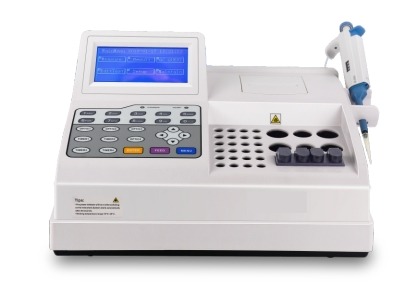Introduction
In modern clinical laboratories, accurate blood testing is paramount, especially when it comes to assessing coagulation (blood clotting). A coagulation analyzer is an essential tool for diagnosing bleeding disorders and monitoring patients on anticoagulant therapies like warfarin or heparin. However, selecting the right coagulation analyzer for your lab is crucial to ensuring accurate results and streamlined operations. This blog will walk you through the key factors to consider when choosing the best coagulation analyzer for your specific needs.
What is a Coagulation Analyzer?
A coagulation analyzer is a laboratory instrument used to assess the efficiency of blood clotting by measuring various clotting factors. These analyzers are primarily used to:
- Monitor anticoagulant therapy (e.g., for patients on warfarin or aspirin)
- Diagnose bleeding disorders such as hemophilia
- Evaluate platelet function and overall clotting status
Coagulation analyzers typically measure parameters like Prothrombin Time (PT), Activated Partial Thromboplastin Time (APTT), and Fibrinogen levels, which are critical for diagnosing and monitoring clotting disorders(Infitek Co., Ltd.).

Key Considerations When Choosing a Coagulation Analyzer
When selecting a coagulation analyzer, there are several key factors you must consider to ensure you get the right tool for your lab's needs.
1. Accuracy and Precision
The accuracy of your coagulation analyzer is paramount. False readings could lead to incorrect diagnoses or treatment plans. When assessing accuracy, look for models that are FDA-approved or CE-marked, which ensures that the device meets high standards for reliability.
Why It Matters:
Accurate readings ensure the proper management of patients, especially those on critical anticoagulant therapy. A slight deviation in test results could lead to complications in patient care(NeedleTube).
2. Cost-Effectiveness
Cost is always a consideration. The upfront cost of a coagulation analyzer may vary significantly, but it’s important to factor in long-term costs such as reagent expenses, maintenance, and calibration.
Tip: Choose a device that balances both upfront costs and long-term operational expenses. A cheaper device may have higher reagent and maintenance costs over time, impacting overall cost-effectiveness(NeedleTube).
3. Testing Capacity and Throughput
Labs with high volumes of coagulation tests require an analyzer with high throughput and fast turnaround times. Some devices can process multiple samples simultaneously, which is ideal for busy hospitals or large clinics.
Higher throughput means less waiting time for results and a smoother workflow, particularly in emergency situations(Infitek Co., Ltd.).
4. Integration with Existing Systems
Modern coagulation analyzers often come with integration capabilities that connect to a Laboratory Information System (LIS) or Electronic Health Records (EHR) system. This improves data accuracy and reduces manual errors.
Why It Matters:
Integration makes it easier to track patient data, and automated reporting reduces the potential for human error during data entry. This is a critical factor for ensuring streamlined lab operations(NeedleTube).
5. Regulatory Compliance and Quality Control
Compliance with regulatory bodies such as the FDA (in the United States) or CE (in Europe) ensures that the analyzer adheres to industry standards for safety and accuracy. Quality control features such as automatic calibration and built-in quality checks can also help maintain the analyzer’s performance over time.
Common Mistakes When Buying a Coagulation Analyzer
Selecting the right analyzer isn’t just about choosing the most expensive or feature-packed device. Many labs make mistakes by focusing on the wrong aspects of a coagulation analyzer. Here are some common pitfalls:
- Ignoring Long-Term Maintenance Costs: Some labs focus solely on the initial purchase price but forget to factor in the ongoing costs of reagents and maintenance. Over time, these costs can add up significantly(NeedleTube).
- Underestimating Throughput Needs: Smaller labs might buy low-throughput analyzers that are underpowered for larger test volumes. Conversely, large labs might invest in high-throughput machines with excessive capacity that they don’t need(Infitek Co., Ltd.).
- Not Considering Automation: Manual or semi-automated systems may work for low-volume labs, but they can lead to human errors and bottlenecks in busy environments(NeedleTube).
Top Features to Look for in a Coagulation Analyzer
When selecting a coagulation analyzer, make sure it includes the following features for the best performance and reliability:
- Automation: Fully automated analyzers can run multiple tests at once and reduce the chances of human error.
- Calibration and Quality Control: Choose a model with built-in calibration and regular quality control features to maintain accuracy.
- Ease of Use: Intuitive interfaces and simple operation can save training time and reduce errors(Infitek Co., Ltd.)(NeedleTube).
Conclusion
Choosing the right coagulation analyzer is essential to ensuring that your lab provides accurate, efficient, and reliable test results. By focusing on factors such as accuracy, cost-effectiveness, throughput, integration, and regulatory compliance, you can make an informed decision that meets the specific needs of your lab.
Remember, while the initial cost is important, the long-term operational costs—like maintenance and reagent usage—can often impact your overall investment. By considering these factors carefully, you'll be better equipped to choose a coagulation analyzer that delivers accurate results, integrates with existing systems, and optimizes your lab's workflow.
Final Tip: Before making your purchase, reach out to manufacturers for demonstrations and customer reviews to ensure you're choosing the right model for your lab's unique requirements. Happy analyzing!
